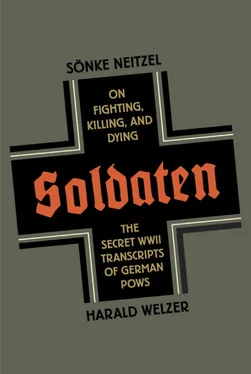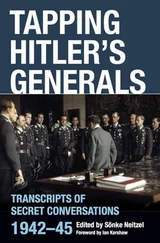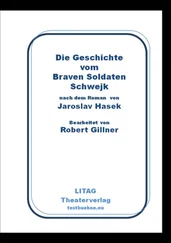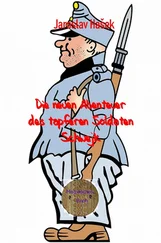Rules are least applicable in ground combat. Wherever soldiers take prisoners, secure occupied territories, and battle partisans, particular forms of logic dominate. Often, that logic revolves around troops’ security or the satisfaction of material and sexual desires. Individually perpetrated violence, such as rape or killing, becomes more possible and likely. In other words, war opens up a social space that is far more violence-friendly than peacetime. Force becomes expected, accepted, and normal. The conditions under which instrumental violence—the taking of territory, the pilfering of the vanquished, and the rape of women—is allowed to change together with the dynamics of the war itself. The same is true of autotelic violence. The borders between the two types of violence are so permeable that distinctions between legitimate and criminal force in battle become exceedingly tenuous. A lot of what the German POWs relate in the surveillance protocols is typical less of crimes committed by the Wehrmacht specifically than of war crimes in general.
The killing, wounding, and raping of civilians is as much a part of the everyday reality of war as the murder of prisoners, the illegal bombardment of nonmilitary targets, and the strategic terrorization of populaces. The Wehrmacht wasn’t the only army to execute prisoners. Both Soviet and U.S. troops did so as well—and not just in World War II. General Bruce Palmer, former acting chief of staff of the U.S. Army, revealed a little bit more than he intended when he wrote: “Americans did indeed commit war crimes in the course of the protracted Vietnam War, but no more in proportion to the number of people involved than have occurred in past wars.” {137} 137 Cited in Joanna Bourke, An Intimate History of Killing (London: Granta Books, 1999), p. 182.
Palmer made explicit what is always assumed about military prohibitions of illegal actions. No one believes that they will not be violated. Nonetheless, the standards of what constitutes a tolerable level of violations of international law varies from historical period to historical period, and from individual to individual. Within the framework of a total war, soldiers push the limits of legitimacy to the extreme. What distinguishes the Nazi campaigns of extermination from the standard general practice of World War II is the elimination of certain groups who had nothing to do with the war itself, as well as the genocidal treatment meted out to Russian POWs, including the execution of Soviet commissars. Here, racist ideology made itself manifest. It translated the situation of warfare into the most radical practice of destruction and annihilation ever seen in the modern age.
Numerous narrative examples of these tendencies occur in the surveillance protocols, although they are not as frequent as German historiography, which tends to focus on Nazi crimes, leads us to expect. The reason why is simple. The things that emerged, after decades of politicized historical arguing, as the signature characteristics of World War II were by no means anything special in the eyes of German soldiers. The vast majority of them knew of Nazi crimes, and no small number of them were actively involved, but those crimes did not occupy any special place in their frame of reference. Soldiers were most concerned with their own individual survival, their next home leave, the loot they could pilfer, and the fun they could have, and not the suffering of others, especially those considered racially inferior. Soldiers’ own fate was always at the center of their perception. Only in rare cases did the fate of enemy troops or occupied peoples seem worthy of note. Everything that threatened one’s own survival, spoiled the fun, or created problems could become a target of unlimited violence.
“Taking care” of partisans was rationalized with the idea that they ambushed German soldiers. Revenge was a powerful motivator and functioned regardless of individual soldiers’ political attitudes. Thus General Wilhelm von Thoma, who was critical of the Nazi leadership, told the British intelligence officer Lord Aberfeldy:
THOMA: There was a terrific amount of shooting there on both sides. Or as when they keep on proudly publishing in the French newspaper the monthly balance sheet, so-and-so-many hundreds of trains blown up, so-and-so-many factories burnt down, four hundred and eighty officers and one thousand and twenty men shot. Damn it all—haven’t the others got the right to shoot these people if they catch them? Of course they have, but they count it all as war crimes. That’s great hypocrisy. {138} 138 SRGG 560, 14 November 1943, TNA, WO 208/4167.
Together with the execution of prisoners, the battle against partisans was the framework in which German soldiers most frequently committed war crimes. The ways in which the German military interpreted international law and the perceptions of individual German soldiers proved a deadly combination. International law did not provide any unambiguous rules for dealing with guerrilla warfare. The 1907 Hague Convention was full of contradictions and open questions concerning the rights and responsibilities of an occupying force. The main problem was not the status of partisans in and of themselves. Insofar as they fulfilled certain conditions, wearing rudimentary uniforms, bearing their arms openly, having a clear command structure, and respecting the laws of warfare, partisans were allowed to assist the armies of their homelands in defensive wars. But the Hague Convention made no mention of what should happen if partisans continued to fight after a state had been forced to capitulate or had been completely occupied. It thus lacked any provision for protecting the rights of resistance movements, even if they wore uniforms. {139} 139 Directly after World War II, two American international law experts acknowledged that only “political and military, rather than legal, considerations” could have held back the German occupying forces. See Lester Nurick and Roger W. Barrett, “Legality of Guerrilla Forces Under the Laws of War,” American Journal of International Law 40 (1946), pp. 563–83. This statement is all the more telling since it came directly after the war from lawyers who were also members of the U.S. Army with little reason to sympathize with the Third Reich. We owe this reference to Klaus Schmider, Sandhurst.
Rules concerning retaliatory measures were even more problematic and contradictory. Article 50 of the Hague Convention allowed collective punitive measures against a civilian population if a connection between partisans and their general environment could be proven. This rule was open to widely divergent interpretation. In the legal discussion of the interbellum years, no international consensus emerged, and the taking of hostages was deemed legitimate everywhere but in France. Opinions differed on whether they could be killed, with German military lawyers taking the hard-line position that the continued existence of “an arena of battle” justified such measures of retribution. This disagreement appeared one last time in the war crimes trials after World War II. The judges in Nuremberg ruled that the main defendants had acted illegally in ordering the killing of hostages, but in subsequent trials, defendants were deemed to have acted within the scope of the law. Convictions in the latter cases were based solely on the excessive ratios (1 to 100) German occupiers had applied when executing hostages. {140} 140 On this discussion, see Lieb, Konventioneller Krieg , pp. 253–57. See also Jörn Axel Kämmerer, “Kriegsrepressalie oder Kriegsverbrechen? Zur rechtlichen Beurteilung der Massenexekutionen von Zivilisten durch die deutsche Besatzungsmacht im Zweiten Weltkrieg,” Archiv des Völkerrechts 37 (1999), pp. 283–317.
Читать дальше












